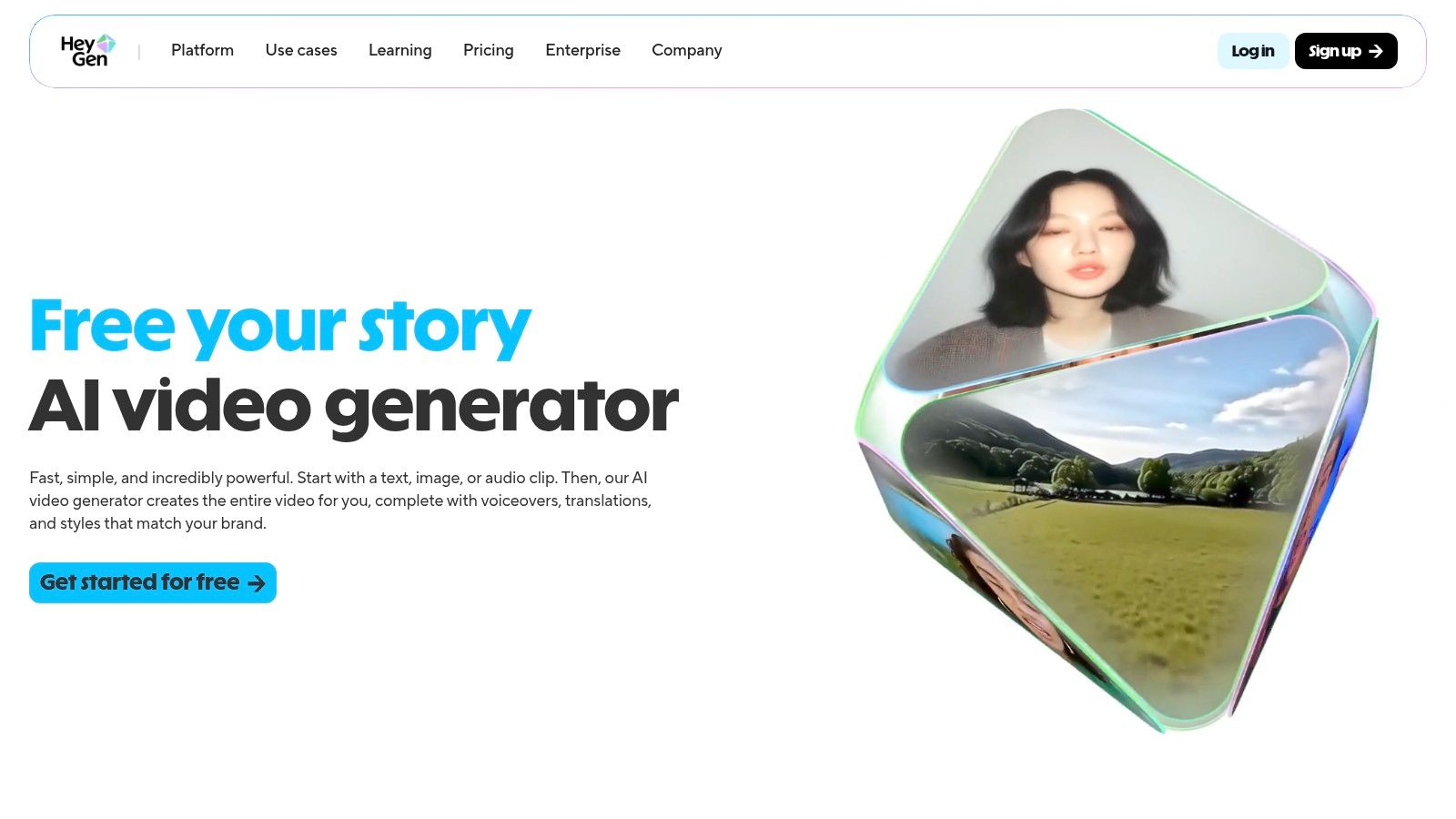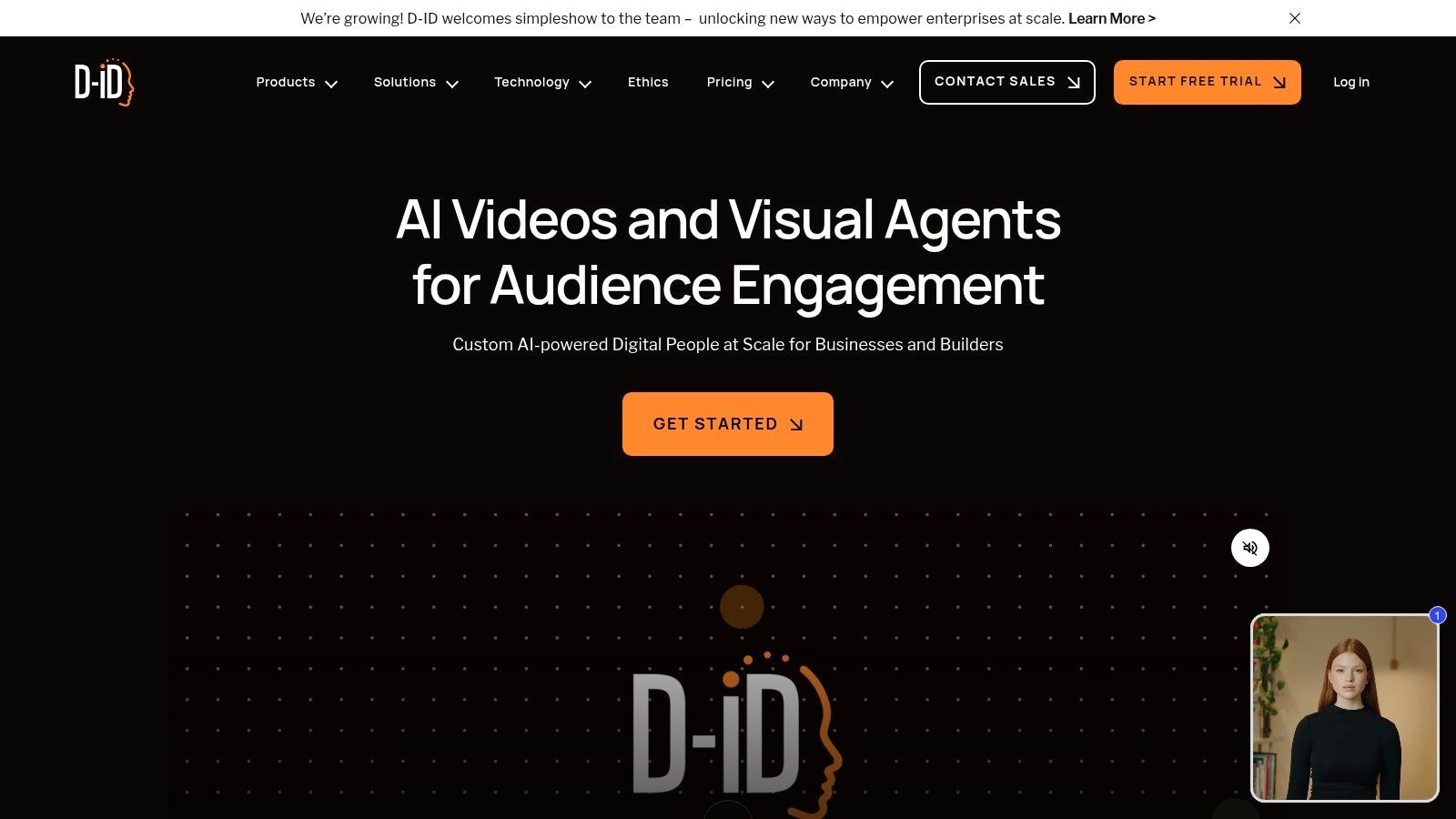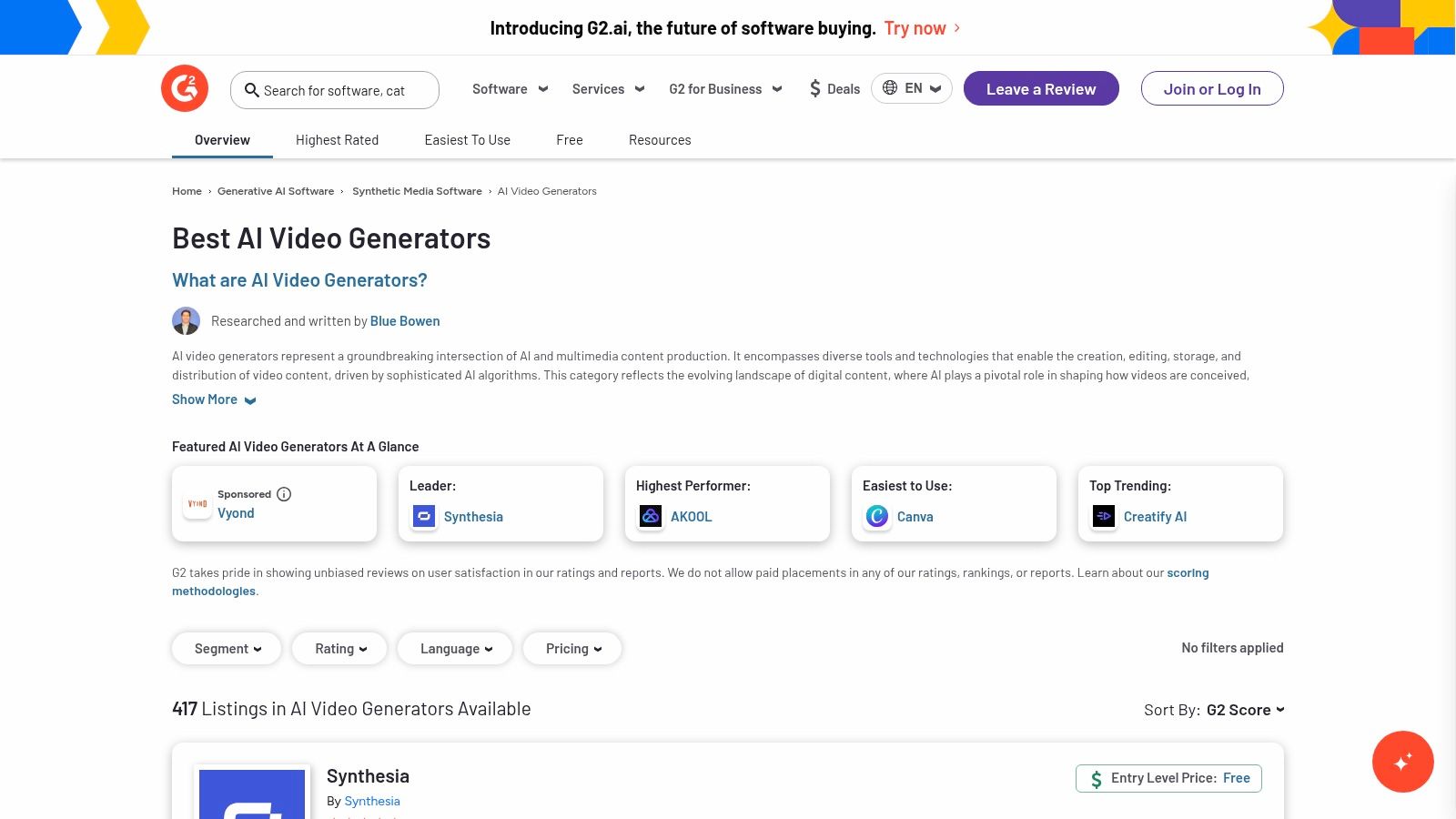The landscape of visual creative work is rapidly evolving, with artificial intelligence leading the charge. For enterprise teams, studios, and brands, the challenge isn't just about adopting new technology, it's about doing so responsibly. Selecting the right AI video generator means balancing creative power with compliance, scalability, and security. This guide cuts through the hype to provide a detailed breakdown of the best AI video generators available today, focusing on practical use cases, honest limitations, and the specific needs of professional creative workflows. We've organised this resource to help you make an informed and safe choice for your organisation.
Each platform reviewed below includes a detailed analysis covering its core features, ideal use cases, pricing structures, and potential drawbacks, complete with screenshots and direct links for easy access. We will explore a range of tools, from those producing cinematic text-to-video outputs to platforms specialising in corporate training videos with custom AI avatars. Our goal is to equip creative directors, project managers, and producers with the insights needed to integrate these powerful tools into their projects effectively and securely. Beyond our detailed analysis, for a quick overview, you might also explore a concise list of other top AI video generators to consider for your projects.
1. Virtuall
Virtuall positions itself as a comprehensive Creative OS, a strategic choice for studios, game developers, and enterprise creative teams seeking to unify their AI-powered workflows. It stands out by integrating 3D model, image, and video generation into a single, collaborative browser-based workspace. This centralised approach is designed to streamline the entire creative pipeline, from initial concept to final asset delivery.
Instead of juggling disparate tools, teams can generate and iterate on assets using multiple leading AI engines, all within the same platform. This multi-engine flexibility allows users to compare outputs for style, quality, and pipeline compatibility, ensuring the best possible result for any given project. This makes Virtuall one of the best AI video generators for teams that require versatility and control over their creative assets.

Key Features and Use Cases
Virtuall's feature set is built for professional team collaboration and production efficiency. The platform’s Kanban-style visual pipelines, version control, and in-browser annotation tools are particularly powerful, keeping project briefs, assets, and feedback organised and accessible.
- Ideal Use Case: A game development studio can use Virtuall to rapidly prototype character concepts, generate environment textures, and create animated cutscenes or marketing videos. The entire process, from initial text prompts to team review and approval, happens in one place, significantly accelerating production cycles.
- Enterprise-Ready: Virtuall emphasizes intellectual property ownership and compliant AI usage, making it a responsible choice for global brands concerned with security and data governance. Its unified AI token system provides clear oversight and control over spending across different AI models.
Pricing and Access
Virtuall does not list public pricing on its website. Access is provided by booking a demonstration or contacting their sales team directly. Costs are managed through a platform-specific AI token system, where expenditure varies based on the AI engine used and the complexity of the generation task.
Pros:
- Unified platform for generating 3D models, images, and video clips
- Centralised workspace with robust version control and review tools
- Flexibility to choose from and compare multiple AI engines
- Strong focus on enterprise compliance, IP ownership, and cost control
Cons:
- No transparent, publicly available pricing model
- Performance is reliant on third-party AI engines and browser capabilities
Website: https://virtuall.pro
2. Runway
Runway has solidified its position as one of the best AI video generators by offering a powerful, integrated suite of creative tools favoured by production teams and artists. It excels in text-to-video and image-to-video generation, enabling users to rapidly prototype concepts, create dynamic b-roll, or generate entire scenes from simple prompts. The platform’s strength lies in its ecosystem, which combines video generation with a robust editor featuring AI-assisted tools like upscaling and post-production effects.

Runway’s approach to pricing is designed for flexibility, using a credit-based system where costs are calculated per second of generated video. This transparency allows teams to manage budgets effectively. A standout feature is the "Unlimited Explore Mode," which lets users experiment extensively without consuming credits, making it ideal for high-volume ideation before committing to a final render. While default clips are short (5–10 seconds), they are easily stitched together for longer sequences. For teams exploring how this technology integrates into production workflows, you can learn more about real-time AI on virtuall.pro.
Key Features and Considerations
- Pros: Transparent credit costs, Unlimited Explore Mode encourages experimentation, comprehensive support documentation.
- Cons: Longer videos require manual stitching, credit-based pricing can be unpredictable for large projects, priority support is reserved for higher-tier plans.
Website: https://runwayml.com
3. Pika
Pika has rapidly emerged as one of the best AI video generators, especially among creators and marketers looking for speed and versatility. It excels at transforming text, images, or existing videos into dynamic new clips using its proprietary models. The platform's strength lies in its user-friendly interface and a suite of specialised editing add-ons like Pikascenes and Pikaswaps, which allow for more creative control over the final output. This makes it an excellent choice for generating social media content, music videos, or quick conceptual animations.
Pika’s pricing is structured around tiered plans that provide a monthly allotment of video credits, with commercial use rights included on all paid tiers. This model is well-suited for individuals and teams with consistent content needs. A key advantage is the detailed credit cost breakdown, which clearly outlines how credits are consumed based on video duration, resolution, and the specific Pika model used. While the credit system can initially seem complex, it offers granular control over spending once understood, ensuring teams can manage their resources effectively.
Key Features and Considerations
- Pros: Affordable entry-level pricing, generous credit allowances on higher-tier plans, commercial rights on paid tiers.
- Cons: Credit accounting can be complex for new users, displayed pricing prioritises annual billing which may be less flexible.
Website: https://pika.art
4. Luma AI Dream Machine
Luma AI has emerged as one of the best AI video generators by focusing on high-fidelity, cinematic outputs with its Dream Machine platform. Powered by its proprietary Ray model family, it excels at producing fluid, coherent video from text and image prompts, making it a strong choice for creative professionals and enterprise users seeking photorealistic results. The platform’s key differentiator is its commitment to quality and transparency, offering clear credit breakdowns for different resolutions, including 4K with HDR.

Luma’s pricing model is built for scalability, with a generous free tier for initial exploration and paid subscriptions that offer commercial use rights and remove watermarks. A unique feature is the “Unlimited Relaxed Mode” on higher tiers, which allows for extensive experimentation without the pressure of credit consumption, catering to teams that need to iterate heavily. While individual clips are short, the platform's frequent model updates and focus on visual quality make it an excellent tool for generating premium b-roll, conceptual visuals, and marketing assets.
Key Features and Considerations
- Pros: Very explicit and transparent pricing, commercial use and no watermarks on paid plans, frequent model updates.
- Cons: Clip length is currently short and requires manual sequencing for longer videos, draft-mode limits on lower-tier plans.
Website: https://lumalabs.ai
5. Synthesia
Synthesia has established itself as a market leader among the best AI video generators, specialising in avatar-led presentations for corporate training, internal communications, and localised marketing content. It enables enterprises to produce professional-quality videos by converting text into speech, delivered by a realistic AI avatar. The platform's core strength is its vast library of stock avatars and extensive language support, making it an efficient solution for creating scalable video content without cameras or microphones.

The platform’s pricing is structured around credits and minutes, offering clear tiers that cater to different organisational needs, from individual creators to large teams requiring SSO and collaborative features. Its standout capability is the support for over 140 languages, including Danish, which is a significant advantage for global enterprises focused on localisation. Synthesia's focus on enterprise-grade security and compliance makes it a trusted choice for corporate environments looking for a safe and scalable video solution.
Key Features and Considerations
- Pros: Reputable enterprise usage and licensing, transparent plan tiers, extensive language support including Danish for localisation.
- Cons: Minute and credit management can add complexity to project planning, full avatar customisation is reserved for higher-cost plans.
Website: https://www.synthesia.io
6. HeyGen
HeyGen has carved out a niche as one of the best AI video generators by focusing on avatar-led content, making it a go-to platform for corporate communication, marketing, and training videos. Its core strength lies in transforming scripts into professional-looking presentations using a vast library of stock and customisable avatars. This approach eliminates the need for cameras, actors, and studios, significantly streamlining the production process for enterprise teams.

The platform is particularly powerful for global teams due to its robust video translation and dubbing features, which maintain natural lip-sync across numerous languages, including Danish. HeyGen's organised workflow, complete with brand kits and templates, supports scalability and brand consistency. While a free plan is available for trial, paid tiers unlock higher resolutions (up to 4K), remove watermarks, and provide faster processing speeds, making it a practical choice for businesses needing to produce high-quality, localised video content efficiently.
Key Features and Considerations
- Pros: Generous free tier for testing, strong support for Danish and other languages, excellent templates and team-focused workflows.
- Cons: Highest quality (4K) and fastest exports are locked behind higher-tier plans, free plan includes watermarks and limitations.
Website: https://www.heygen.com
7. Canva
Canva has positioned itself as an all-in-one design powerhouse, and its Magic Studio suite brings accessible AI video generation into its ecosystem. While not a dedicated text-to-video platform like others, it excels at integrating AI-assisted tools into a familiar editing workflow. Users can generate short video clips with Magic Media (its text-to-video feature), then immediately assemble them using Canva's vast library of templates, stock assets, and text tools. This makes it one of the best AI video generators for teams needing to produce social media content quickly without specialised editing skills.
The platform is designed for efficiency, allowing marketing teams and content creators to maintain brand consistency through Brand Kits and collaborate in real-time. Its strength lies in simplifying the entire content creation process, from ideation to publishing. While some advanced AI features have usage caps on lower-tier plans, the integrated nature of Canva’s tools provides a seamless experience for creating polished videos with minimal effort. It is an enterprise-ready solution ideal for organisations prioritising ease of use and brand compliance.
Key Features and Considerations
- Pros: All-in-one suite simplifies graphics and video workflows, team-friendly collaboration and brand control features, continuously expanding AI toolset.
- Cons: Recent pricing changes for teams have caused user backlash, some AI features have usage caps on lower-tier plans.
Website: https://www.canva.com
8. VEED.IO
VEED.IO positions itself as a comprehensive web-based video editor that has brilliantly integrated AI capabilities, making it a strong contender among the best AI video generators. Instead of developing a single proprietary model, its unique "AI Playground" allows users to select from various state-of-the-art third-party text-to-video and image-to-video models. This approach gives creators the flexibility to experiment with different generative styles within one seamless interface, combining asset creation with a full suite of editing tools for subtitles, audio cleanup, and final publishing.

The platform operates on a credit-based system for AI generation, which is available on its Pro and Enterprise plans. A key benefit is its transparency, as the tool displays the credit cost before you commit to generating a clip, which aids in budget management. This editor-first approach is ideal for teams that need to not only generate content but also polish and prepare it for distribution. Efficiently managing these AI-generated assets is crucial, and you can explore solutions for video asset management on virtuall.pro.
Key Features and Considerations
- Pros: Single interface to access and try many frontier models, comprehensive editor tools for post-production, occasional promos and educational offers.
- Cons: AI generation is not available on the free plan and requires paid credits, model choice affects credit burn and pricing can vary.
Website: https://www.veed.io
9. CapCut
CapCut has rapidly evolved from a popular mobile video editor into a comprehensive, cross-platform tool that ranks among the best AI video generators for social content creators. Its strength lies in its accessibility and seamless integration of AI features into a user-friendly editing environment. Users can leverage text-to-video, image-to-video, and an AI script writer directly within the platform, making it incredibly efficient for generating short-form content for platforms like TikTok and Instagram.

The platform’s generous free tier allows users to access a wide array of tools, including templates, AI avatars, and voiceover features, without an initial investment. This makes it an ideal starting point for individuals and small teams looking to experiment with AI-driven video production. While some advanced AI functionalities and higher-resolution exports are reserved for CapCut Pro subscribers, the core feature set provides more than enough power for producing high-quality social media videos quickly and efficiently.
Key Features and Considerations
- Pros: Powerful free tier with broad functionality, clear how-to guides for AI video generation, widely used for rapid social-format production.
- Cons: Some AI features may be region-limited, CapCut Pro is required to unlock certain premium features and higher export options.
Website: https://www.capcut.com
10. D-ID
D-ID specialises in generating talking-head videos, making it one of the best AI video generators for creating digital presenters and interactive agents. The platform excels at transforming static images, text prompts, or uploaded voice recordings into expressive, animated avatars. This focused approach makes it ideal for producing training materials, corporate communications, and automated customer service responses where a human-like presenter adds a personal touch.

The platform is designed for seamless integration into existing creative workflows, offering plugins for popular tools like Canva and PowerPoint alongside a powerful API for custom solutions. D-ID uses a credit-based system, where one credit typically generates up to 15 seconds of video, providing a predictable cost structure. Its clear watermark policy on trial and lower-tier plans, combined with a dedicated ethics page, allows businesses to test the technology responsibly before committing to a paid plan.
Key Features and Considerations
- Pros: Fast talking-avatar creation for specific use cases, clear watermark and ethics policy, plugin ecosystem for common workflows.
- Cons: Pricing and promotions can change, requiring verification at checkout; watermarks on trial and lower-tier outputs may limit immediate use.
Website: https://www.d-id.com
11. Colossyan
Colossyan establishes itself as one of the best AI video generators for corporate learning and development (L&D), focusing on creating professional, avatar-led training content. Its platform is specifically engineered to streamline the production of educational materials, allowing enterprise teams to convert scripts into polished videos featuring AI presenters. The core strength of Colossyan lies in its specialised toolset, which includes features like automated translation, multi-avatar dialogue scenes, and interactive elements designed for effective workplace training.

The platform’s pricing is structured around annual minute bundles, making it predictable for corporate budgets, with Business plans offering unlimited minutes. A key differentiator is its support for languages like Danish and its seamless integration into L&D workflows with SCORM-compliant exports. This makes it an ideal solution for organisations looking to localise training content at scale without sacrificing quality or engagement. While its template-first approach simplifies creation, it offers less freeform creative control compared to general-purpose editors.
Key Features and Considerations
- Pros: Highly specialised for training and L&D workflows, competitive pricing for its niche, excellent localisation and language support.
- Cons: Less creative flexibility than non-linear editors, some premium features like custom studio avatars require paid add-ons.
Website: https://www.colossyan.com
12. G2 (AI Video Generators category)
Instead of being a generator itself, G2’s dedicated category for AI video generators serves as an essential research hub for teams evaluating different platforms. It aggregates user reviews, satisfaction scores, and detailed product information, allowing businesses to compare the best AI video generators side-by-side. This marketplace approach is invaluable for shortlisting vendors, understanding real-world performance, and making an informed purchasing decision before committing to a subscription or enterprise plan.

G2’s strength lies in its structured data and filterable views, which help creative directors and project managers quickly identify solutions that fit specific requirements, such as enterprise-grade security or specific integration capabilities. The platform provides direct links to vendor websites, free trials, and demo requests, streamlining the procurement process. While its "featured" placements can reflect sponsorships, the sheer volume of aggregated user feedback provides a balanced perspective that is crucial for any serious evaluation.
Key Features and Considerations
- Pros: Broad coverage of vendors, high-level summaries from user feedback, regularly updated content.
- Cons: Sponsored placements can influence visibility, some reviews may lack technical depth, requiring further research.
Website: https://www.g2.com/categories/ai-video-generators
Top 12 AI Video Generators Comparison
Making a Responsible Choice for Your Creative Future
The landscape of AI video generation is evolving at an incredible pace, transforming how creative teams conceptualise and produce visual content. We've explored a diverse range of platforms, from the cinematic text-to-video power of Runway and Luma AI, to the polished avatar-based solutions offered by Synthesia and HeyGen. Each of these tools presents a unique set of capabilities designed to address specific creative and business challenges.
Your journey to find the best AI video generators should be guided by a clear understanding of your team's specific needs. A freelance marketer might find the accessible, template-driven approach of Canva or VEED.IO perfectly sufficient for creating social media content. In contrast, a game development studio or a visual effects team will require the sophisticated control, high-fidelity output, and collaborative features found in more specialised platforms.
Key Takeaways and Strategic Considerations
As you evaluate your options, move beyond a simple feature-for-feature comparison. Instead, consider these crucial strategic factors:
- Workflow Integration: How well does a potential tool fit into your existing production pipeline? A standalone generator might create impressive clips, but a unified platform that integrates asset management and collaborative review cycles, like Virtuall, can deliver far greater efficiency gains for enterprise teams.
- Data Security and IP Protection: For professional studios, intellectual property is paramount. It is vital to scrutinise each provider's data handling policies, security certifications, and terms of service regarding content ownership. Adopting new AI tools introduces new variables into your security posture. When relying on external providers, understanding the security implications is key. Delve deeper into managing these risks with our guide on third-party risk management to ensure your creative assets remain protected.
- Scalability and Compliance: Your chosen solution must grow with your ambitions. Consider whether the platform can support larger teams, more complex projects, and meet the stringent compliance standards required in a corporate environment. A tool that centralises creative operations helps maintain brand consistency and operational oversight as your organisation scales.
Your Next Steps
To make an informed decision, we recommend a hands-on approach. Shortlist two or three generators from this list that most closely align with your primary use case. Dedicate time to running a small pilot project on each platform, testing the same prompts and creative concepts to establish a direct comparison of output quality, speed, and user experience. This practical evaluation will reveal which tool not only meets your technical requirements but also empowers your team's creativity most effectively.
Choosing the right AI partner is a foundational decision for your creative future. By prioritising a responsible, secure, and integrated approach, you can harness the revolutionary power of AI to not just accelerate your workflow, but to unlock new levels of innovation safely and efficiently.
Ready to unify your creative workflow and harness AI responsibly? Virtuall provides a secure, enterprise-grade Creative OS that centralises asset generation, management, and collaboration. Move beyond fragmented tools and discover how a single, compliant platform can accelerate your entire production pipeline. Explore Virtuall to see how we empower professional teams to create at the speed of imagination.











